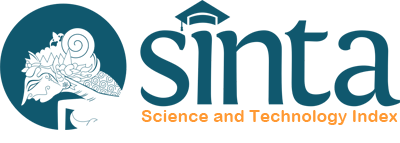SHIFTING PHENOMENON: AN ANALYSIS OF STAND UP COMEDY INDONESIA
Abstract
The lengthy road of Stand Up Comedy Indonesia has not been in vain, as it has become a popular event with many followers. Stand-Up comedy is today well-known not only due to the excitement of the show but also because the content delivered is of excellent quality and suited for all audiences. However, many comedians whose careers were launched by Stand-Up Comedy have since changed careers. This is, of course, a topic worthy of further investigation. This study tries to analyze the growth of stand-up comedy in Indonesia by examining the paths of comedians who left their comfort zones for new careers. To solve the research topic, the primary issue is the path of a former stand-up comedian who now works in a different field. Consequently, this study combines descriptive qualitative methodologies with various data acquired via content analysis on social media platforms such as YouTube, TikTok, and Instagram. According to Raskin (1985), psychological theory predominantly analyses comedy. Hence humour theories from a psychological perspective are highly developed. This study demonstrates that ups and downs have marked the long journey of Stand Up Comedy Indo until it has become popular and well-liked by the people of Indonesia. On the other hand, the author discovers that at the height of their careers, the comedians who pioneered Stand Up Comedy have shifted to other fields. This study also demonstrates that Stand Up Comedy has spawned a new generation of comedians who will continue the fantastic work of senior comedians.
Keywords
Full Text:
PDFReferences
Abdul, O., Mahbub, R., & Ab, A. (2018). Stand Up Comedy, Stand Up Comedy Indonesia, Satire, Diskriminasi, Semiotika, John Fiske. 071511533055, 1–16.
Badara, A. (2018). Stand-up Comedy Humor Discourse in Local Perspective in Indonesia. International Journal of Applied Linguistics and English Literature, 7(7), 222. https://doi.org/10.7575/aiac.ijalel.v.7n.7p.222
Comedy, M. (n.d.). Complete eBook Workbook ( 1 ). 1.
E, I. N. (2017). FROM COURT JESTING TO MICROPHONE COMEDY : Towards a History of Nigeria ’ s Stand-up Comedy. January 2015.
Fadillah, E. R. (2015). Stand-Up Comedy Indonesia Season 4 Di Kompas Tv. In (Doctoral dissertation, Universitas Negeri Semarang).
Filani, I. (2015). Discourse Types in stand-up comedy performance. European Journal of Humour Research, 3(1), 41–60.
Friedman, S. (2012). Cultural omnivores or culturally homeless? Exploring the shifting cultural identities of the upwardly mobile. Poetics, 40(5), 467–489. https://doi.org/10.1016/j.poetic.2012.07.001
Jones, R. (1985). Giving patients a say. Nursing Times, 81(15), 36.
Krissandi, A. D. S., & Setiawan, K. A. C. (2018). Kritik Sosial Stand Up Comedy Indonesia Dalam Tinjauan Prakmatik. Pena : Jurnal Pendidikan Bahasa Dan Sastra, 7(2), 46–59. https://doi.org/10.22437/pena.v7i2.5316.
Marlin, C., Warouw, D. M. D., & Kalangi, J. . (2017). Fenomena Tayangan Stand Up Comedy Di Kompas Tv. E-Journal Acta Diurna, VI(2), 1–11.
Petra, U. K. (2007). Jiunkpe-Is-S1-2013-51408079-27402-Humor-Chapter2. 2000, 12–29.
Rutter, J. (1997). Stand-up as interaction: Performance and audience in comedy venues. Core, September, 400. https://core.ac.uk/download/pdf/1664527.pdf%0Ahttp://citeseerx.ist.psu.edu/viewdoc/download?doi=10.1.1.123.729&rep=rep1&type=pdf
Scarpetta, F., & Spagnolli, A. (2009). The Interactional Context of Humor in Stand-Up Comedy. Research on Language & Social Interaction, 42(3), 210–230. https://doi.org/10.1080/08351810903089159
Triana, N. (2021). Komika Stand Up Comedy Dalam Perspektif Industri Budaya (Studi Kasus Pandji Pragiwaksono). Jurnal Studi Komunikasi (Indonesian Journal of Communications Studies), 5(1), 165. https://doi.org/10.25139/jsk.v5i1.2952
Wells, P., & Bull, P. (2007). From politics to comedy: A comparative analysis of affiliative audience responses. Journal of Language and Social Psychology, 26(4), 321–342. https://doi.org/10.1177/0261927X07306978.
DOI: http://dx.doi.org/10.22441/visikom.v22i02.17774

This work is licensed under a Creative Commons Attribution-ShareAlike 4.0 International License.
Jurnal Visi Komunikasi [p-ISSN 1412-3037 | e-ISSN 2581-2335]
Fakultas Ilmu Komunikasi Universitas Mercu Buana
Jl. Raya Meruya Selatan, Kembangan, Jakarta 11650
Tlp./Fax: +62215870341
http://publikasi.mercubuana.ac.id/index.php/viskom

This work is licensed under a Creative Commons Attribution-NonCommercial 4.0 International License.
Jurnal Visi Komunikasi was indexed by :





